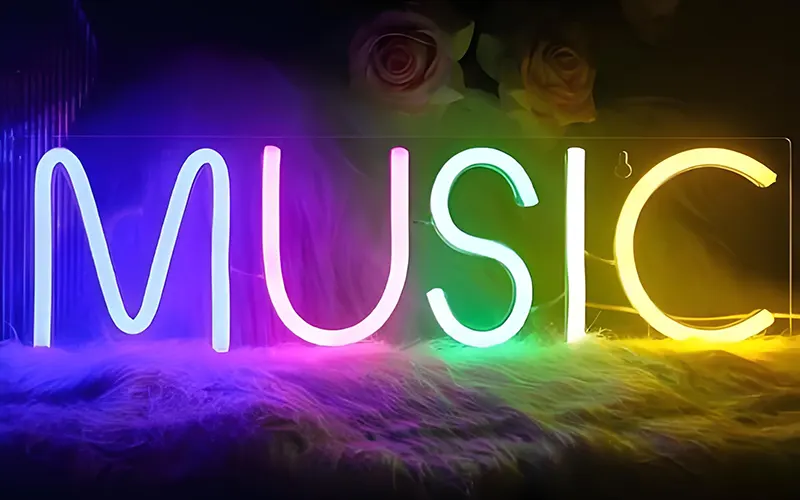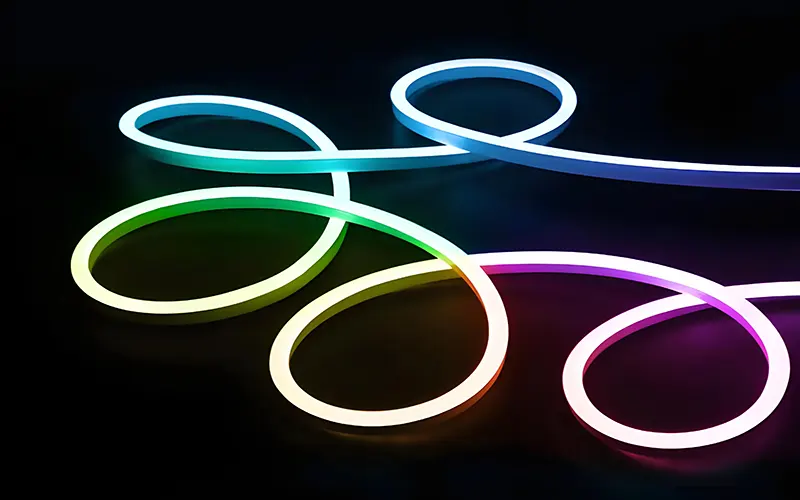LED neon strips are popular for their soft lighting effects, different sizes and flexible installation. High-quality LED neon strip is widely used in commercial decoration, home atmosphere lighting, advertising signs and other fields. High-quality LED neon strip not only require excellent photoelectric performance, but also must have reliable structural design, excellent material quality and strict production process control.
However, high quality standards and testing systems are the key to ensuring the quality of LED neon strip. For example, international certification requirements, photoelectric performance indicators, environmental adaptability, mechanical reliability and service life. Let’s take a look at the steps and certifications required for LED neon strips to ensure quality. You can read Everything You Need to Know Before Buying LED Neon Flex
Which Certificates of LED Neon Tubes are Worth Paying Attention To?
We can first pay attention to some international general certifications of high quality LED neon strip. Because it is the basic threshold for LED neon strips to enter the global market.

CE certification
We believe that CE, RoHS and UL certifications are the most important. CE certification (Conformité Européenne) is a mandatory certification mark of the European Union, indicating that the product complies with the relevant EU directives, including electromagnetic compatibility, low voltage directives and energy efficiency requirements.
LED neon strips that have obtained CE certification must pass strict electrical safety tests. To ensure that they will not pose a threat to personal safety under normal use conditions.
RoHS Certification
RoHS certification (Restriction of Hazardous Substances) limits the use of hazardous substances in electronic and electrical products, including heavy metals such as lead, mercury, cadmium, hexavalent chromium, and flame retardants such as polybrominated biphenyls.
High-quality LED neon strips must strictly control the content of these hazardous substances, not only to meet environmental protection requirements, but also to ensure the safety and recyclability of the product.
UL Certification
UL certification (Underwriters Laboratories) is an important safety certification in the North American market, with a special focus on the fire safety performance of products.
UL-certified LED neon strips must meet strict standards in terms of material flame retardancy, electrical insulation, and thermal management.
LM-80 and TM-21 certificates
Among the optoelectronic performance standards, the LM-80 and TM-21 tests are of special significance. The LM-80 standard specifies the test method for the luminous flux maintenance rate of LED light sources, requiring continuous operation for more than 6,000 hours under specific temperature conditions and recording the luminous flux attenuation.
Based on the LM-80 data, TM-21 predicts the service life of LEDs through mathematical models, providing users with reliable life expectancy. These two tests combined can scientifically evaluate the long-term performance of LED neon strips.
What are the High Quality Standards for Raw Materials of LED Neon Strip?
Regarding high-quality LED neon strip, we need to inspect from raw materials and luminous tests, you can take these as reference.

LED chips
When it comes to raw materials, the first thing we think of is LED chips. Because it is the core component of neon strips, the choice of chip brand directly affects the product’s light efficiency, color consistency and service life.
First of all, European and American brand chips such as OSRAM and Cree have excellent performance in light efficiency and reliability. But the cost is high and the delivery time is long.
In addition, Taiwanese brand chips such as Epistar and Epistar have advantages in cost performance, while mainland brand chips such as Sanan Optoelectronics have outstanding cost control capabilities while their technical level is constantly improving.
Chip quality testing mainly includes forward voltage testing, photoelectric conversion efficiency testing and color coordinate consistency testing. The consistency of forward voltage reflects the stability of the chip manufacturing process, and the voltage deviation should be controlled within ±0.1V.
Waterproof silicone tube UV test
The UV resistance and weather resistance test of waterproof silicone sleeve is very important. Because the ultraviolet radiation in the outdoor application environment will cause the silicone material to age and turn yellow.
The standard UV aging test uses a xenon lamp or ultraviolet lamp as the light source, and continuously irradiates for more than 1000 hours under specific temperature and humidity conditions to observe the color change, mechanical property attenuation and transmittance change of the material.
The transmittance reduction of high-quality silicone sleeves after UV testing should be less than 5%, and the yellowing level should be controlled within level 3.
PCB board quality
The inspection of PCB board quality focuses on copper thickness and thermal conductivity. Copper thickness directly affects the current carrying capacity and heat dissipation performance of the circuit. The copper thickness of standard LED neon strips should reach 2oz (70μm) or more, and high-power products require 3oz (105μm) or thicker.
The thermal conductivity test evaluates the heat dissipation capacity of the PCB board. The thermal conductivity of the aluminum substrate should reach 1.5W/m·K or more to ensure that the heat generated by the LED chip can be effectively conducted and dissipated.
Key indicators of light and color temperature
Color rendering index (CRI) is an important indicator for evaluating the light quality of LED neon strips. Products with CRI ≥ 90 can truly restore the color of objects. The realization of high CRI values requires optimization in the spectrum design of LED chips, usually by adding red light chips or using high-quality phosphors to improve the red color rendering ability.
Color tolerance (SDCM) controls the color consistency of LED neon strips. The smaller the SDCM value, the better the color consistency of the product. For high-quality products. SDCM should be controlled within 3 steps, and top products even require SDCM ≤ 2.
Professional testing process for waterproof and dustproof
IP protection level testing is an important part of LED neon light quality control. IP65 level requires complete dustproof and can prevent any dust from entering.
IP67 level adds short-term immersion requirements on the basis of IP65, which is more suitable for outdoor waterproofing, but it is not recommended for underwater use.
IP68 level is the highest waterproof level, requiring long-term immersion in water without water ingress. It is usually required to be immersed in water at a depth of 1.5 meters for more than 24 hours.
High and low temperature environment adaptability test
The operating temperature range of LED neon strips is usually set at -20°C to 50°C, covering the climate conditions in most regions.
The temperature test includes high temperature working test, low temperature start-up test and temperature cycle test. The high temperature working test works continuously for 72 hours at 50°C to check the photoelectric performance changes and structural integrity of the product.
Conclusion
The standard and testing system for high-quality LED neon strip is a complex and systematic project, with quality control throughout the entire process from raw materials to final products. International certification and optoelectronic performance standards provide the basis for product quality, while material quality testing, environmental adaptability testing, and mechanical reliability verification ensure the stability and durability of the product in actual use. More details, pls read How to Find the LED Neon Flex Manufacturer and Supplier?
FAQs
The certificates that generally need attention are CE (EU market safety mark) and RoHS (environmentally friendly and free of hazardous substances). In addition, there are electrical certificates, UL and ETL certificates that are required in the United States.
CRI (color rendering index) represents the ability of light to restore the true color of an object. Nowadays, LED neon tubes are generally CRI80 and CRI90. Light strips with CRI≥90 display more natural and realistic colors.
Yes, but you need to use products that have been tested for high and low temperatures. High-quality neon strips can usually work normally in an environment of -20°C to +50°C without cracking or losing light, and are suitable for high latitudes or plateaus.
High-quality LED neon strips can indeed reach or approach a 50,000-hour lifespan. When purchasing, you need to confirm its shelf life with the supplier.
